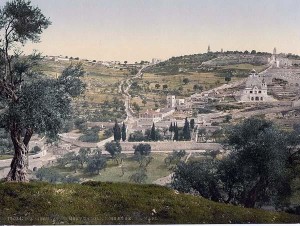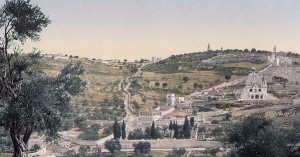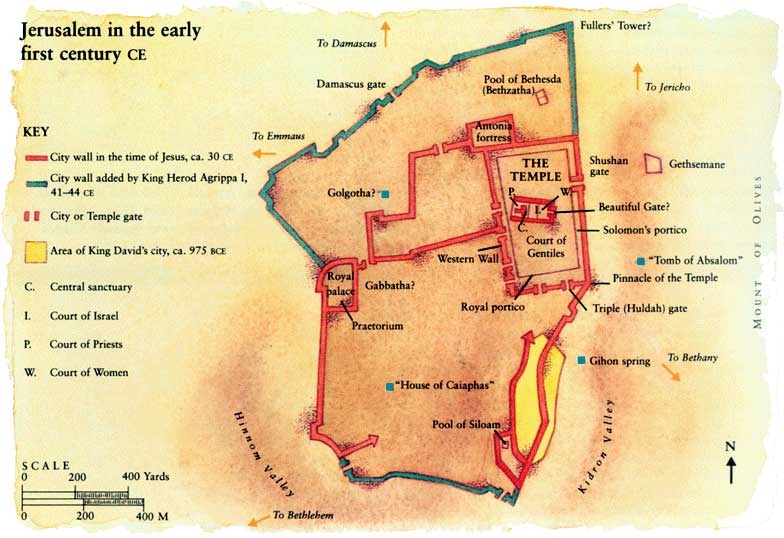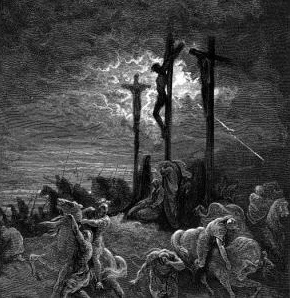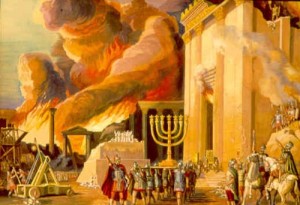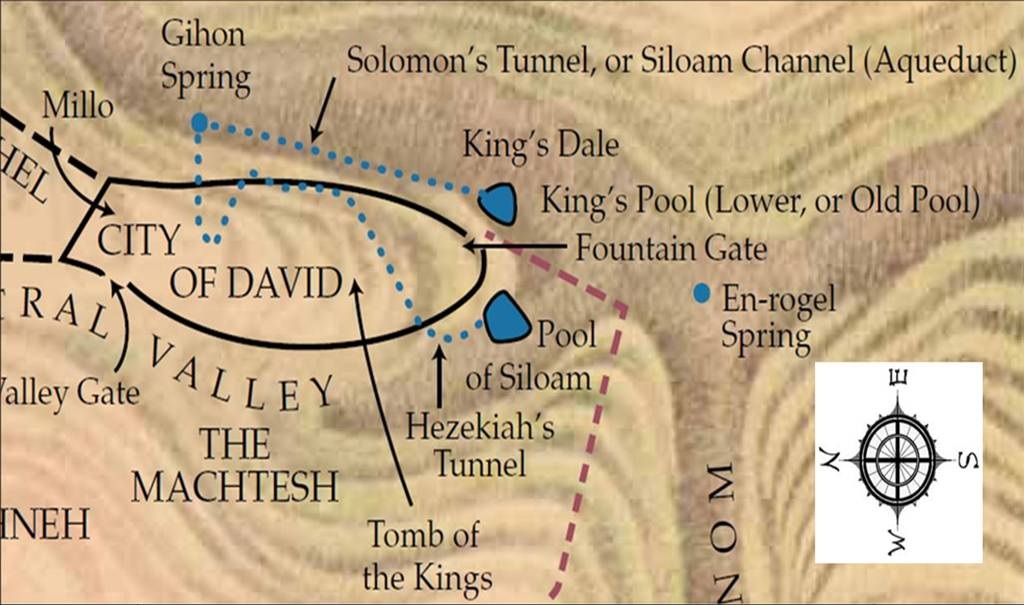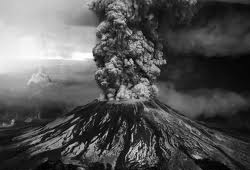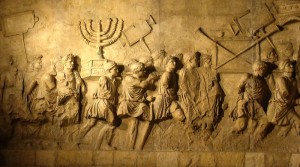Zechariah 14 Fulfilled–including the splitting of the Mount of Olives!
Zechariah 14 Fulfilled–including the LITERAL splitting of the Mount of Olives: Summary and Highlights
Though Zechariah 14 was likely fulfilled in the Maccabean Wars of the second century B.C., these prophecies may have a dual fulfillment in the Jewish War in the first century A.D. (see Zechariah 14 Fulfilled in the Maccabean Wars: A Preterist Commentary.) In Zechariah 14:2, the prophet predicts that “all the nations [will be gathered] to Jerusalem to fight against it.” This seems to have been fulfilled when the Roman legions and auxiliaries consisting of a vast array of ethnic groups from all over the known world attacked Jerusalem in A.D. 70. Then in Zechariah 14:4, Zechariah predicts that the Mt. of Olives was to be split in two. Confirmation of the fulfillment of this verse is found in the fact that the Mt. of Olives is split in two today. In A.D. 66, at the start of the Jewish War, an army of angels appeared in the clouds according to two first century historians. This supernatural specter may fulfill v. 5: “Then the LORD my God will come, and all the holy ones with him.” One month before this army of angels appeared in the sky, a miraculous light from the Temple lit up the city of Jerusalem so bright “that it appeared to be bright daytime”1 in the middle of the night. This miracle may fulfill v. 7: “When evening comes, there will be light.” In the next verse, Zechariah predicts that water will flow out of Jerusalem “half to the eastern sea and half to the western sea.” This may have been fulfilled in A.D. 70 when the Roman army began its siege of Jerusalem and water flowed in abundance to the Pool of Siloam to the west and the King’s Pool to the east of the city. In v. 12 the Lord threatens to “strike all the nations that fought against Jerusalem [such that t]heir flesh will rot while they are still standing on their feet, their eyes will rot in their sockets, and their tongues will rot in their mouths.” A couple years after Israel’s war with Rome, Mount Vesuvius erupted releasing a colossal surge cloud that engulfed the surrounding Roman cities of Pompeii, Herculaneum, Stabiae and Oplontis in an incendiary cloud of smoke, lava and ash. Burning at approximately one thousand degrees Fahrenheit, this volcanic ash would have killed the people in these cities in roughly three to five seconds—their flesh beginning to be consumed before their bodies even hit the ground. Zechariah 14 closes with the following prediction: “And on that day there will no longer be a Canaanite in the house of the LORD Almighty.”2 In A.D. 70, the Romans destroyed the Temple, the “house of the LORD Almighty,” making it impossible for anyone to physically enter. For a detailed explanation of how Zechariah 14 may have also been fulfilled in the first century see the following commentary on Zechariah 14.
The following may seem unbelievable. However, all information is taken from unbiased historical records and is easily verifiable. Sources listed at the end.
Zechariah 14 Fulfilled–including the splitting of the Mount of Olives!
1 A day of the LORD is coming when your plunder will be divided among you. 2 I will gather all the nations to Jerusalem to fight against it; the city will be captured, the houses ransacked, and the women raped. Half of the city will go into exile, but the rest of the people will not be taken [cut off] from the city.
Fulfilled! Zechariah 14:2 Commentary: The Roman Legions and Auxiliaries that Attacked Jerusalem consisted of a vast Array of Ethnic Groups from all over the Known World in Fulfillment of v. 2: “I will gather all the Nations to Jerusalem to fight against It.”
In vs. 2, Zechariah predicts that the LORD will “gather all the nations to Jerusalem to fight against it.” The Roman army that attacked Jerusalem in A.D. 70 was not exclusively Roman. It consisted of a number of auxiliary cohorts. These auxiliary cohorts consisted of soldiers that were not Roman citizens and thus were comprised of a diverse array of ethnic groups.

The Destruction of the Temple at Jerusalem. by Nicolas Poussin. (Gemäldegalerie, 1638-1639) Kunsthistorisches Museum.
Fulfilled! Zechariah 14:2 Commentary: Both Zechariah and Jesus predicted that half of the People of Jerusalem would be exiled and half would not.
Verse 2 corroborates Jesus’ prediction in Matthew 24:40-41 and Luke 17:24-35. Both Zechariah and Jesus appear to assert that at the time of the end half of the people in Jerusalem would be exiled and half would not. In The Wars of the Jews 6.8.2, Josephus says that the surviving citizens of Jerusalem were allowed to stay in the metropolis after the conquest of the city: “Only the citizens [of Jerusalem] were allowed to remain [in the city]; all the rest were sold, along with the women and children for a trifling price per head, as supply was far in excess of demand.”
The Romans began their siege of Jerusalem on Passover. During this holiday, Jews from all over the world converged on Jerusalem. Josephus says that 1,100,000 Jews were killed during the siege of Jerusalem and that the majority of these casualties were not citizens of the city. Josephus also says that the Romans exiled 97,000 people during the entire course of the war.3 This is exactly what one would expect. Visitors to Jerusalem would likely only carry as much money with them as they felt would be necessary to travel to and stay in Jerusalem during the week-long festival. These travelers would be the first to run out of money and subsequently perish from the rising cost of food as a consequence of the famine induced by the siege of the city. In contrast, the citizens of Jerusalem profited greatly from the Passover celebration. And they also would have had access to all their savings since they lived in the city. Maybe the number of pilgrims who survived the siege was equivalent to the number of citizens who also survived? If this was the case, then the pilgrims would have been exiled from the city and the citizens would have been allowed to stay. Thus one-half of the city would have been exiled and the rest would have been allowed to remain in the city in fulfillment of Matthew 24:40 and Zechariah 14:2.
3 Then the LORD will go out and fight against those nations, as he fights in the day of battle.
Fulfilled! Zechariah 14:3 Commentary: In the Middle of the Jewish War, Rome was afflicted with Civil War.
Though God had used Rome as a weapon against Israel, Rome did not remain unscathed. In A.D. 69, the war in Israel came to an abrupt halt while Rome was torn apart by civil war and countless calamities resulting in the death of four Caesar’s over the course of just one year. That year Rome suffered what may have been its most tumultuous year in its long history. But even after all this; God’s anger was still aflame: God’s next act of vengeance is described in vs. 12-15.
4 On that day his feet will stand on the Mount of Olives, east of Jerusalem, and the Mount of Olives will be split in two from east to west, forming a great valley, with half of the mountain moving north and half moving south. 5 You will flee by my mountain valley, for it will extend to Azel. You will flee as you fled from the earthquake in the days of Uzziah king of Judah.
Fulfilled! Zechariah 14:4 Commentary: Did the Glory Cloud depart from the Temple in A.D. 66 and stand atop the Mt. of Olives for Three and a Half Years?
Citing the Midrash, Ernest L. Martin in his book Secrets of Golgotha: The Forgotten History of Christ’s Crucifixion claims that a rabbi named Jonathan witnessed the departure of the Shekinah or Glory Cloud from the Temple in A.D. 66. The Shekinah is the presence of God. And the Glory Cloud is the visible manifestation of God’s presence. After leaving the Temple, the Shekinah or Glory Cloud then allegedly sat atop the Mt. of Olives for three and a half years before rising up to heaven several months prior to the arrival of Titus and his army at Jerusalem in A.D. 70.4 If this event did, in fact, occur during the Jewish War as Martin claims, then this event literally fulfills Zechariah 14:4: “On that day his [God’s] feet will stand on the Mount of Olives, east of Jerusalem[.]” See Did the Glory Cloud Leave the Temple and Settle Atop the Mt. of Olives for Three and a Half Years During the Jewish War? Regardless of whether or not this event occurred during the Jewish War, the fact that God stood on the Mt. of Olives is confirmed by the fact that the Mount of Olives was split in two from east to west by a Roman road in the first century.5
Fulfilled! Zechariah 14:4-5 Commentary: The Mount of Olives was literally split in Two from East to West by a Road in the First Century.
Some preterist scholars assume that verses like Isaiah 26:7, Isaiah 40:4, Isaiah 49:11 and Micah 1:3-6 were fulfilled in a non-literal manner, if this is true then this idea implies that the splitting of the Mt. of Olives may also not have been fulfilled literally. However, though poetic and therefore often hyperbolic, apocalyptic expressions like these vs. cited above were fulfilled surprisingly literally in Old Testament history (see How and Why Prophecies with Apocalyptic Imagery May Have Been Fulfilled in Old Testament History Much More Literally than Previously Thought.) If there is a literal cornel of truth to even the most fantastic Old Testament apocalyptic predictions, then it follows that the Mt. of Olives must have in some manner split in two as prophesied in Zechariah 14:4-5.
The Mt. of Olives is and was cut threw the middle by a first century Roman road that formed what looks like a valley through the middle of the mountain. The photograph above of the Mount of Olives was taken a little over a hundred years ago. This photo clearly shows the Mount of Olives split through the middle by a road. This road splitting the mount of Olives in two from north to south dates back at least to the first century.
According to the early church historian Eusebius, “the members of the Jerusalem church, by means of an oracle given by revelation to acceptable persons there, were ordered to leave the City before the war began and settle in a town in Peraea called Pella.6 Fleeing the imminent war, Jewish Christians sought refuge in the city of Pella. Sympathetic to Rome, Pella was a perfect hiding place. Did Jewish Christians pass through the Mt. of Olives east of Jerusalem on their way east to Pella?
Fulfilled! Zechariah 14:4-5 Commentary: The Christians of Jerusalem most likely passed through the Mt. of Olives on Their Way to Pella in Fulfillment of Zechariah 14:4-5.
The most logical path to Pella would have been to travel directly east over the Mt. of Olives until hitting the Jordan River. The Jordan serves as a much-needed water supply for thirsty travelers in addition to an accurate guide north to Pella. These Jewish Christians would have also benefited from traveling directly east to this river, rather than northeast, so as to have an accessible water supply as well as to most thoroughly search the entire river for any possible dry or shallow parts in which to cross.

Both Pella and the Mt. of Olives are east of Jerusalem, thus it would seem that the early Church would have likely used the road through the Mt. of Olives on their way east to Pella.

The eastern gate of the Temple was rebuilt by the Byzantines after being destroyed by the Romans in A.D. 70.
Fulfilled! Zechariah 14:4-5 Commentary: Did Jesus stand on the Mt. of Olives at the Start of the Jewish War?
In Ezekiel 43:4, the prophet sees the LORD of hosts entering the Temple through the gate facing east. The LORD then speaks to the prophet instructing him to lock the eastern gate so that no one can pass through it except the prince himself. In these verses Jesus, the prince of the heavenly host, passes over the Mount of Olives east of Jerusalem. Is Jesus on the Mt. of Olives because he is about to enter the eastern gate of the Temple?
While describing several miraculous signs which had immediately preceded the war with Rome, Josephus says:
[T]he eastern gate of the inner [court of the] temple, which was of brass, and vastly heavy, and had been with difficulty shut by twenty men, and rested upon a basis armed with iron, and had bolts fastened very deep into the firm floor, which was there made of one entire stone, was seen to be opened of its own accord about the sixth hour of the night.7
Though it is unclear from Josephus’ writings on which day this event transpired, according to Josephus, this gate opened at the sixth hour of the night on either the eighth day of Nisan or during the feast of unleavened bread, a couple days later.8 Interestingly, the eastern gate of the Temple was said to have opened exactly twelve hours after Jesus had been nailed to the cross, on the sixth hour of the day.9 Furthermore, the eighth day of Nisan was the day before Jesus’ triumphal entry into Jerusalem. And the feast of unleavened bread was the holiday during which Jesus was crucified.
If, in fact, this event transpired on the eighth of Nisan, this would not have been the first time Jesus had traversed this path. On the following day, approximately thirty-three years earlier, Jesus rode a donkey on this same mountain road over the Mount of Olives during his triumphal entry into Jerusalem.10 Assuming the eastern gate had opened during the feast of unleavened bread is perhaps just as remarkable. This was the feast during which Jesus was crucified at the sixth hour of the day. The fact that this miracle occurred at the sixth hour of the night may hint toward this event. Therefore either day provides significance to this mysterious poltergeist phenomenon.
What transpired within the Temple seemingly after the eastern gate had opened is described in vs. 6 and 7. It is interesting to note that this event is said to have occurred exactly twelve hours after Jesus breathed His last on the cross.11 But before describing this miracle and how it relates to the crucifixion, the prophet is given a glimpse of another mysterious specter also seen over the skies of Judea in A.D. 66.
Then the LORD my God will come, and all the holy ones with him.
Fulfilled! Zechariah 14:5 Commentary: During the Second Coming, Jesus was expected to come on the Clouds in the Presence of the Heavenly Host. A Multitude of Angels were seen in the Clouds in A.D. 66 at the Start of the Jewish War.
On the twenty-first day of Jyar in A.D. 66, a month after the eastern gate had miraculously opened, it is written: “Chariots and troops of soldiers in their armor were seen running about among the clouds[.]”12 The army mentioned above would seem to be the heavenly host riding alongside Jesus during the initial aspect of his second coming, an event described in greater detail in Revelation 19:11-16.
The fact that Jesus returned in the presence of all the holy ones suggests that Jesus, as promised, had inherited His father’s kingdom. In Deuteronomy 33:2, Moses revealed to the people that when God descended on Mount Sinai and Mount Paran the Lord came with a myriad of His holy ones. Christ’s return mirrors this appearance. Like the God of Israel’s descent on Mount Sinai, Christ also comes on a cloud in the company of the heavenly host.
In many instances in which the second coming is described the Greek word parousia is used. In many of these instances, the technical usage of the term is implied. Here the word denotes the arrival at a city of an imperial emissary, an emperor or a conquering general.13 What better word to describe Christ’s return? Generals and emperors do not travel alone. They are typically accompanied by a retinue. These attendants serve and protect the official. In the same way, someone as important as the Messiah would almost certainly be accompanied by the heavenly host. Many Christians mistakenly believe that Christ would return alone. According to the New Testament, Jesus is expected to return in the presence of the holy angels. This fact is made clear in Mark 8:38, Luke 9:26, 1 Thessalonians 3:13, Jude 14 and Revelation 19:11-14. The same message is found in Zechariah 14:5. As both king and general, Jesus rides at the head of his victorious army.14
The medieval Jewish historian Sepher Yosippon expounds upon this angelic army in the sky of A.D. 66 by saying, “Moreover, in those days were seen chariots of fire and horsemen, a great force flying across the sky near to the ground coming against Jerusalem and all the land of Judah, all of them horses of fire and riders of fire.”15 Notice that Yosippon says that this army flew near to the ground around Jerusalem. While at the head of this army did Jesus touch down on the Mt. of Olives outside of Jerusalem when He flew near to the ground with His army around Jerusalem? If so then one can appreciate the literal fulfillment of v. 4: “On that day his feet will stand on the Mount of Olives, east of Jerusalem[.]”
6 On that day there will be no light, no cold or frost. 7 It will be a unique day, without daytime or nighttime—a day known to the LORD. When evening comes, there will be light.
Fulfilled! Zechariah 14:6-7 Commentary: A Miraculous Light from the Temple lit up Jerusalem turning Night to Day at the Start of the Jewish War. Day Became Night during the Crucifixion.
In these two verses, Zechariah predicts that during the time of the end there will be a day without daylight and a night without darkness. Is there any historical record of such an event? In describing the crucifixion of Jesus, the author of Luke writes, “It was now about the sixth hour, and darkness came over the whole land until the ninth hour, for the sun stopped shining.”16 In these verses Luke says that darkness came over the land from the sixth to the ninth hour of the day during Jesus’ crucifixion. This is the day without light predicted by Zechariah in v. 6. (Day also became night shortly after the death of the lawless one. See The Historical Appearance of Christ at the Death of the Beast Fulfills 2 Thessalonians 2:8 and Revelation 19:19-20.)
This is not the only recorded incidence in the annals of history in which the natural order of day and night were violated. Approximately thirty three years later among the miraculous signs immediately preceding the Jewish revolt against Rome, a bazaar event is said to have occurred at the ninth hour. This time it was the ninth hour of the night. Josephus writes, “[O]n the eighth day of the month Xanthicus [Nisan], and at the ninth hour of the night, so great a light shone round the altar and the holy house, that it appeared to be bright daytime; which light lasted for half an hour.”17
Fulfilled! Zechariah 14:6-7 Commentary: Night turned to Day at the Ninth Hour–Twelve Hours after the Temple Curtain tore in Two at Jesus’ Death at the Ninth Hour of the Day.
After describing the darkness over the land during Jesus’ crucifixion, Luke says, “The curtain of the temple was torn in two.”18 This event corresponds with Jesus’ death on the cross presumably at the ninth hour. In other words after His death, Jesus entered the Temple as a sacrifice for sin. The ghostly light at the ninth hour of the night in A.D. 66 originated at the altar and the Temple itself implying that Jesus had returned to commemorate His sacrifice having done so this time at the ninth hour of the night, twelve hours after His death on the ninth hour of the day. But why would Jesus return to the Temple?
Fulfilled! Zechariah 14:6-7 Commentary: The Messiah’s Second Visit to the Temple May Fulfill the Custom of the Daily Sacrifice.
The Messiah’s second visit to the Temple may fulfill the Jewish custom of the daily sacrifice. According to Exodus 29:38, the priests were to offer one lamb in the morning and another in the evening every day. It seems that Jesus had entered the Holy of Holies twice, once at the ninth hour of the day and again at the ninth hour of the night before the harvest at the end of the age. But is there any other significance to these two violations of nature?
Fulfilled! Zechariah 14:6-7 Commentary: The Fact that Day turned to Night and Night to Day is a Miraculous Sign that God had Broken His Covenant with David and the Levites.
These two supernatural phenomena meet the criteria set forth in Jeremiah 33:20-21:
“This is what the LORD says: ‘If you can break my covenant with the day and my covenant with the night, so that day and night no longer come at their appointed time, then my covenant with David my servant—and my covenant with the Levites who are priests ministering before me—can be broken and David will no longer have a descendant to reign on his throne.
Fulfilled! Zechariah 14:6-7 Commentary: The Breaking of the Covenant of Day and Night explains why the Levites no longer minister in the Temple. It also explains why the Messiah Rules at the Right Hand of God in Heaven and not Corporally in Israel.
In the verses above the prophet is told that if day and night do not come at their proper time, God’s covenant with David will be broken and the Levites will no longer minister in the Temple. Is there a historical link between the day of darkness and the breaking of the Davidic covenant? And if so, is there also a correspondence between the light from the Temple and the end of the Levitical priesthood?
Yes. Jesus was a direct descendant of King David. According to John 11:47-53, the chief priests and Pharisees killed Jesus out of fear that they would lose their positions of authority and that the Romans would attack Israel if it united under another king other than Caesar.19 The Jewish elite were successful in their plot. And Jesus was sentenced to death making it impossible for Jesus to rule on David’s throne. The darkness that covered the land during Christ’s execution was a sign from God that because Israel had killed their Messiah, Israel would not be ruled on earth by a king in David’s royal bloodline.20
The miraculous light recorded in Josephus’ account of the Jewish War is similarly tied to the end of the Levitical priesthood. Four years after the mysterious light recorded by Josephus, the Romans destroyed the Temple. With the Temple destroyed, the Levites could no longer offer sacrifices to the LORD. And as a result, all aspects of Jeremiah 33:20-21 had been fulfilled.21
8 On that day living water will flow out from Jerusalem, half to the eastern sea and half to the western sea, in summer and in winter. 9 The LORD will be king over the whole earth. On that day there will be one LORD, and his name the only name.
Fulfilled! Zechariah 14:8 Commentary: Water flows to the East of the Old City of Jerusalem at the King’s Pool and to the West at the Pool of Siloam.
Israel is bordered by the Sea of Galilee and the Dead Sea to the east and the Mediterranean Sea to the west. These seas may be represented by the King’s Pool to the east of the old city of David and the Pool of Siloam to the west. Water flows from the Gihon Spring underground through Hezekiah’s tunnel to the Pool of Siloam. From the Pool of Siloam water flows through a channel to the King’s Pool or the Lower Pool.22
Fulfilled! Zechariah 14:8 Commentary: At the Death of the Two Witnesses an Abundance of Water flowed to the Pool of Siloam to the West and the King’s Pool to the East.
According to Revelation 11:6, the two witnesses are given the “power to shut up the sky so that it will not rain during the time they are prophesying.” As is explained in the commentary on Revelation 11, the two witnesses prophesied for 42 months from the arrival of the Roman army at Jerusalem under Cestius in Tishri of A.D. 66 to the siege of Jerusalem in Nisan of A.D. 70. Josephus tells of a drought that nearly dried up the pool of Siloam as well as all the other springs around the city before the arrival of the Roman army. Then when the Romans began their siege and the two witnesses were killed and therefore silenced, the water overflowed:
Those springs that were formerly almost dried up when they were under your [the people of Jerusalem’s] power since he [the Roman general Titus] is come, run more plentifully than they did before; accordingly, you know that Siloam, as well as all the other springs that were without the city, did so far fail, that water was sold by distinct measures; whereas they now have such a great quantity of water for your enemies, as is sufficient not only for drink both for themselves and their cattle, but for watering their gardens also.23
With the abundance of water in the Pool of Siloam and the King’s Pool one can appreciate a literal element of fulfillment to v. 8: “On that day living water will flow out from Jerusalem, half to the eastern sea and half to the western sea. . . .”
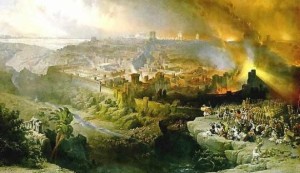
Roberts, David. The Siege and Destruction of Jerusalem by the Romans Under the Command of Titus, A.D. 70 . 1850. Yeshiva University Museum, New York.
After the Jewish War and the subsequent Bar-Kokhba rebellion, there was a new earth, the new, holy Jerusalem of Revelation 21 and Revelation 22.24 In vs. 8 and 9, Zechariah predicts that living water, also signifying the Holy Spirit, will flow over the land of Israel.25 The fact that these waters flowing to the eastern and western seas symbolize the Holy Spirit is implied in John 7:38-39: “Whoever believes in me, as Scripture has said, rivers of living water will flow from within them.” By this he meant the [Holy] Spirit, whom those who believed in him were later to receive.”
These verses are fulfilled in the new Jerusalem during the Thousand Year Reign. During the thousand years between the Jewish War and the Crusades, Israel and its religious capital, grew to become almost exclusively Christian. Filled with the Holy Spirit, this nation enjoyed unprecedented blessing and peace (see Revelation 20: A Preterist Commentary).

The conquest of Jerusalem by the Crusaders in A.D. 1099. Signol, Emile. Taking of Jerusalem by the Crusaders. 1847.
10 The whole land, from Geba to Rimmon, south of Jerusalem, will become like the Arabah. But Jerusalem will be raised up and remain in its place, from the Benjamin Gate to the site of the First Gate, to the Corner Gate, and from the Tower of Hananel to the royal winepresses. 11 It will be inhabited; never again will it be destroyed. Jerusalem will be secure.
Fulfilled! Zechariah 14:10-11 Commentary: Despite being destroyed by the Romans, Jerusalem remains to this Day.
In vs. 2 and 11, the prophet predicts that Jerusalem would be destroyed, the houses pillaged, the women raped and many of the people exiled. Zechariah was right. Jerusalem had been destroyed by the Romans, and during the whole war 97,000 Jews were exiled.26 Regarding the desolation of the city, Josephus writes:
Now as soon as the army had no more people to slay or to plunder, because there remained none to be the objects of their fury, (for they would not have spared any, had there remained any other work to be done,) Caesar gave orders that they should now demolish the entire city and temple, but should leave as many of the towers standing as were of the greatest eminency.27
Then in v.10, Zechariah says that “Jerusalem will be raised up and remain in its place.” As predicted, Jerusalem was rebuilt on its original site and still remains there to this day.
Fulfilled! Zechariah 14:11 Commentary: Jerusalem will Never again be Destroyed?
The NIV quoted above translates v. 11 to say that Jerusalem will never again be destroyed. This is a bit of an overstatement. Of course Jerusalem had been attacked after the Maccabean Wars. Jerusalem was subsequently destroyed during the Jewish War and the Crusades. The NASB translates this verse as follows: “People will live in it [Jerusalem], and there will no longer be a curse, for Jerusalem will dwell in security.” The NET Bible also translates this verse in similar language: “And people will settle there, and there will no longer be the threat of divine extermination—Jerusalem will dwell in security.” These translations are certainly more accurate historically. After the Jewish War, Jerusalem did experience peace for a time though this does not mean that it was never again going to be attacked.
The Bible often uses hyperbole for emphasis. Similar prophecies are found in Isaiah 32:14-20 and Jeremiah 50:40. In Isaiah 31:8, Jerusalem’s miraculous deliverance from the Assyrian army (Is 37:36) is predicted. Then in Isaiah 32:14, Isaiah uses the term “forever” to refer to the roughly seventy-year long desolation of Jerusalem by the Babylonians in the sixth century B.C.: “The fortress will be abandoned, the noisy city deserted; citadel and watchtower will become a wasteland forever[.]” In Isaiah 32:14 “forever” is a period of roughly seventy years. Similarly, concerning the fall of Babylon by the Medes and Persians, Jeremiah 50:40 reads, “As I overthrew Sodom and Gomorrah along with their neighboring towns,’ declares the Lord, ‘so no one will live there [Babylon]; no people will dwell in it.’” Though Babylon never retained its former glory and was, in fact, made desolate by the Medes and Persians, from that point on throughout history some people have lived there to a small extent. Other examples of hyperbole like Matthew 2:1-3; 4:8 and 10:22 have been cited above. Zechariah 14:11 is just one of many examples in which the Bible uses hyperbole for emphasis. Though Jerusalem had enjoyed a time of peace after the Maccabean Wars, it was destroyed sometime later by the Romans.
12 This is the plague with which the LORD will strike all the nations that fought against Jerusalem: Their flesh will rot while they are still standing on their feet, their eyes will rot in their sockets, and their tongues will rot in their mouths.
Fulfilled! Zechariah 14:12 Commentary: The Eruption of Vesuvius May Fulfill v. 12.
Under Titus’ leadership, Jerusalem was attacked and destroyed. Nine years after this military victory, Titus succeeded his father as emperor of Rome. During this time, I believe God patiently waited to fulfill the plague described in v. 12. After Titus, the Roman general responsible for Jerusalem’s desolation, had at last become emperor of Rome in June of A.D. 79, the scourge of Zechariah 14:12 may have been released.
In August of that year, Mount Vesuvius erupted destroying Pompeii, Herculaneum, Stabiae and Oplontis. When Mount Vesuvius erupted, a colossal surge cloud rushed down the mountain engulfing the surrounding cities in an incendiary cloud of smoke, lava and ash. Burning at approximately one thousand degrees Fahrenheit, five times hotter than boiling water, this volcanic ash would have killed the people of Pompeii and the surrounding cities in roughly three to five seconds. The flesh of many of these people would have begun to be consumed even before their bodies dropped to the ground fulfilling v.12: “Their flesh will rot while they are still standing on their feet, their eyes will rot in their sockets, and their tongues will rot in their mouths.” Concerning the magnitude of this eruption and its aftermath, Cassius Dio writes:
Indeed, the amount of dust, taken all together, was so great that some of it reached Africa and Syria and Egypt, and it also reached Rome, filling the air overhead and darkening the sun. . . .These ashes, now, did the Romans no great harm at the time, though later they brought a terrible pestilence upon them.28
Concerning the plague induced by the ashes of Vesuvius, Suetonius writes that it was “one of the worst outbreaks of plague that had ever been known.”29 Cassius Dio also says that this ash “wrought much injury of various kinds. . . .”30 The plague described in v. 12 may be the fifth plague of Revelation 16:11, the plague of boils. Perhaps this burning ash and the subsequent pestilence it caused also brought about tissue necrosis, rotting the flesh of those affected, as is suggested in v. 12 and Revelation 16:11?
Fulfilled! Zechariah 14:12 Commentary: Did Acid Rain Caused by the Eruption of Vesuvius Also Cause the Painful Sores of Revelation 16:11 and the Tissue Rot of Zechariah 14:12?
Volcanic eruptions often release great amounts of sulfuric dioxide into the atmosphere. When this gas reacts with water vapor it forms sulfuric acid which falls to the ground as acid rain. Could the tissue rot mentioned in Zechariah 14:12 and the “pains” and “sores” of Revelation 16:11 have also been induced by especially-caustic acid rain? For additional details see the commentary on Revelation 16:10-11 in Revelation 16: A Preterist Commentary.
13 On that day men will be stricken by the LORD with great panic. Each man will seize the hand of another, and they will attack each other. 14 Judah too will fight at Jerusalem. The wealth of all the surrounding nations will be collected—great quantities of gold and silver and clothing.
Fulfilled! Zechariah 14:13 Commentary: The Panic at the Eruption of Vesuvius . . .
Describing the panic induced by the eruption of Mt. Vesuvius, Cassius Dio writes in fulfillment of v. 13: “Therefore they fled, some from the houses into the streets, others from the outside into the houses, now from the sea to the land and now from the land to the sea; for in their excitement they regarded any place where they were not as safer than where they were.”31 In the next verse, Cassius Dio states that the citizens of Pompeii were seated at the theater when the eruption took place.32 Were the people of Pompeii watching Jewish prisoners of war forced to dual to the death? Were they watching gladiatorial combat or any other type of hand to hand combat as was commonly presented in Roman theaters in fulfillment of v. 13: “Each man will seize the hand of another, and they will attack each other”?33

The siege of Jerusalem.Hayez, Francesco. The Destruction of the Temple of Jerusalem. 1867. Galleria d’Arte Moderna, Venice.
Fulfilled! Zechariah 14:13-14 Commentary: In A.D. 69, in the Middle of the Jewish War, there were Civil Wars in both Israel and Rome. Jewish Rebels from all over Israel converged on Jerusalem where they fought Each Other in a Three-Way Civil War.
In vs. 13-14 Zechariah seems to shift back to speaking about the fate of Old Covenant Jerusalem during the Jewish War. Verse 13 speaks of civil war. One year after the death of Nero Caesar, Rome suffered three civil wars, conflict in Judea and Gaul and various attacks from foreigners.34 Civil war also spread like a plague throughout the cities of Israel between the zealots who desired independence from Rome and those wanting peace.35 As the Roman army swept through Israel, refugees from conquered cities fled to Jerusalem.36 Here the young and strong plundered the old and multitudes were killed in broad daylight.37 In time those who did not want a war with Rome waged an unsuccessful campaign against their zealot oppressors and a “great slaughter was made on both sides.”38 A three-way civil war also began among the zealots who had fled to Jerusalem.39 In time the whole city of Jerusalem was divided against itself and dead bodies covered the streets even before the Roman army fired their first arrow into the city in seeming fulfillment of verses 13 and 14: “Each man will seize the hand of another, and they will attack each other. Judah too will fight at Jerusalem.”
Fulfilled! Zechariah 14:14 Commentary: Jerusalem was plundered.
On Passover of A.D. 70, during the festival in which Jesus was crucified, Rome began its assault on Jerusalem. Five months later Jerusalem fell. Concerning the plundering of Jerusalem, Josephus writes, “And now all the soldiers had such vast quantities of the spoils which they had gotten by plunder, that in Syria a pound weight of gold was sold for half its former value.”40 This wealth came from the Jews of all the nations of the inhabited earth whose tithes were the cause of Jerusalem’s immense wealth. It was this wealth that ultimately came from all the surrounding nations that was plundered in fulfillment of v. 14. The wealth of the city was carried off to Rome, and many of Jewish prisoners of war were pitted against each other in mortal combat in the Roman public arenas appearing to fulfill vs. 13 and 14.41
15 A similar plague will strike the horses and mules, the camels and donkeys, and all the animals in those camps.
Fulfilled! Zechariah 14:15 Commentary: The Eruption of Vesuvius May Also Fulfill v. 15.
According to Cassius Dio, the eruption of Mount Vesuvius “wrought much injury of various kinds, as chance befell, to men and farms and cattle. . . .”42 That being said, perhaps the plague that infected the people of Rome after the eruption of Mt. Vesuvius also infected “the horses and mules, the camels and donkeys, and all the animals”? If the tissue rot predicted in Zechariah 14:12 was induced by acid rain caused by the eruption of Vesuvius, then this plague would have affected livestock especially prominently since many of these animals were in the open field and therefore would have been unable to find shelter from the caustic effects of prolonged exposure to acid rain.
16 Then the survivors from all the nations that have attacked Jerusalem will go up year after year to worship the King, the LORD Almighty, and to celebrate the Feast of Tabernacles. 17 If any of the peoples of the earth do not go up to Jerusalem to worship the King, the LORD Almighty, they will have no rain. 18 If the Egyptian people do not go up and take part, they will have no rain. The LORD will bring on them the plague he inflicts on the nations that do not go up to celebrate the Feast of Tabernacles. 19 This will be the punishment of Egypt and the punishment of all the nations that do not go up to celebrate the Feast of Tabernacles.
Fulfilled! Zechariah 14:16-17 Commentary: Because the Law was fulfilled at the Destruction of the Temple in A.D. 70, the Practice of the Celebration of the Feast of Tabernacles Cannot be Literal.
In Matthew 5:17 Jesus promises to fulfill the Law. The fulfillment of the Law is mentioned in Hebrews 8 and 9. Colossians 2:16-17 reads, “Therefore no one is to act as your judge in regard to food or drink or in respect to a festival or a new moon or a Sabbath day—things which are a mere shadow of what is to come; but the substance belongs to Christ.” When the Temple was destroyed by the Romans in A.D. 70 it became impossible to follow the Law of Moses. Therefore, the destruction of the Temple was the ultimate sign of the fulfillment and subsequent passing away of the Law. The fact that the Law had been fulfilled in A.D. 70 means that God would not mandate the literal restoration of the custom of the Feast of Tabernacles at a later date especially since in order to partake of this feast requires animal sacrifice (Leviticus 23:37). For this reason even futurists generally do not believe that this prophecy is literal since it makes null and void Jesus’ sacrificial death for the sins of the world.
I believe that the Feast of Tabernacles is a prophetic celebration which is a symbolic shadow of the resurrection of the dead. Thus the practice of this celebration is ultimately fulfilled in the resurrection. Though the resurrection is the heavenly fulfillment of vs. 16-19, there also appears to be an earthly shadow or mirror to these predictions.
Fulfilled! Zechariah 14:16 Commentary: Who were the Survivors from All the Nations?
Before addressing the earthly shadow of this prophecy, let us first take another look at v.16. Zechariah 14:16 says that “the survivors from all the nations that have attacked Jerusalem will go up year after year to worship the King, the LORD Almighty, and to celebrate the Feast of Tabernacles.” The first thing to note concerning this prophecy is that as explained many times thorough these commentaries all or every does not always mean all or every in the Bible (Matthew 2:1-3; 4:8; 10:22; Luke 18:31).
Fulfilled! Zechariah 14:16-17 Commentary: Because the Christian Saints are Both the New Temple (1 Peter 2:5) and the New Jerusalem (Revelation 21 and 22) and their Lives are Spiritual Sacrifices to God (Romans 12:1), then the Christian Saints May in and of Themselves fulfill All the Stipulations of the Feast of Tabernacles in a Spiritual Sense in the New Covenant Age.
The new covenant equivalent of the Feast of Tabernacles appears to be the Christian church itself. How could the Christian church be the New Covenant equivalent of the Feast of Tabernacles? The reason is because the sacrifices once performed during the Feast of Tabernacles during the Old Covenant are performed spiritually in the lives of the Christian saints. 1 Peter 2:5 says, “[Y]ou [the Christian church] also, like living stones, are being built into a spiritual house to be a holy priesthood, offering spiritual sacrifices acceptable to God through Jesus Christ.” Thus according to 1 Peter 2:5, the Christian church, the new temple of God, replaces the old temple in Jerusalem. Likewise, because of Jesus’ sacrificial death on the cross the holy lives of the Christian saints are the “spiritual sacrifices acceptable to the God” that replaces the Old Covenant sacrifices once performed in this temple during the Feast of Tabernacles. This notion of the saints as living sacrifices is also echoed in Romans 12:1: “Therefore I urge you, brethren, by the mercies of God, to present your bodies a living and holy sacrifice, acceptable to God, which is your spiritual service of worship.” Perhaps it is partially because the Christian saints are spiritual sacrifices to God that they are collectively called the Body of Christ, the ultimate symbolic antitype of these Old Covenant sacrifices?
If the Christian saints represent both the Temple and the sacrifices performed during the Feast of Tabernacles, what about the pilgrimage aspect of this feast? During the Feast of Tabernacles, the Jewish people were expected to make a pilgrimage to Jerusalem in order to celebrate this feast. As explained in the commentary on Revelation, the New Jerusalem of Revelation 21 and 22 is the Christian church. Thus this pilgrimage aspect of the Feast of Tabernacles in which Jews were expected to celebrate this feast in Jerusalem is no longer necessary because the Christian church is the New Jerusalem. Therefore, because the Christian saints are both the new temple of God and the New Jerusalem and their lives are spiritual sacrifices to God, then the Christian saints in and of themselves fulfill all the stipulations of the Feast of Tabernacles in a spiritual sense in the new covenant age.
Zechariah 14:16-17 says that if the people of the earth do not participate in the Feast of Tabernacles they will have no rain. As explained above the Feast of Tabernacles appears to be fulfilled in the Christian church. It is interesting to note that the preponderance of all Muslim nations throughout the Middle East and North Africa are arid countries. Is the fact that these non-Christian countries have little to no rain a coincidence or could this fact be the fulfillment of these verses today?
20 On that day HOLY TO THE LORD will be inscribed on the bells of the horses, and the cooking pots in the LORD’s house will be like the sacred bowls in front of the altar. 21 Every pot in Jerusalem and Judah will be holy to the LORD Almighty, and all who come to sacrifice will take some of the pots and cook in them. And on that day there will no longer be a Canaanite in the house of the LORD Almighty.
Fulfilled! Zechariah 14:20-21 Commentary: HOLY TO THE LORD was etched on the High Priest’s Forehead. This Mark of God allows entry into the Presence of God.
God created Adam and his descendants out of dirt like a potter fashioning pottery out of clay (Genesis 2:7). Thus mankind is often represented as pottery in vs. like Romans 9:21 and 2 Corinthians 4:7.
The inscription HOLY TO THE LORD was etched into a gold plate over the high priest’s forehead whenever he entered the inner sanctuary of the temple. As is stated in Hebrews 8:5, the temple sanctuary is an earthly shadow of heaven. This mark on the forehead allows access into the presence of God in heaven in the same way that it allowed the high priest to enter the presence of God in the inner sanctuary of the temple. The fact that the inscription HOLY TO THE LORD is found on the bells of the horses, the cooking pots and the sacred bowls in v. 20 suggests that these bells, cooking pots and sacred bowls ultimately represent spirits in or destined for heaven. Therefore, these two verses may be an allegorical representation of the resurrection of the saints.
In Revelation 14:1 the Jewish saints are said to have the name of the LORD written on their foreheads.43 This mark on the foreheads of the saints in the Book of Revelation is the inscription HOLY TO THE LORD, the same descriptive title found on the forehead of the high priest. This mark on the forehead allows access into the presence of God at the resurrection in the same way that it allowed the high priest to enter the presence of God in the inner sanctuary of the temple.
However, the house of the LORD Almighty, the temple of God, mentioned in verse 21 is not merely a heavenly temple. It is also an earthly one. As stated above, 1Peter 2:5 says, “[Y]ou [the Christian church] also, like living stones, are being built into a spiritual house to be a holy priesthood, offering spiritual sacrifices acceptable to God through Jesus Christ.” The Christian church is the new temple of God largely because its members are ultimately allowed access into God’s temple in heaven at the resurrection. This being the case, the sacrifices offered in v. 21 might not be literal lambs and bulls, but rather the lives of the saints as is indicated in Romans 12:1.
Fulfilled! Zechariah 14:21 Commentary: Canaan is the Territory approximating the Boundaries of Israel. In this Verse Canaanites are Ethnic Jews.
In v. 21 Zechariah says, “Every pot in Jerusalem and Judah will be holy to the LORD Almighty.” As stated above, the pots etched with the inscription HOLY TO THE LORD appear to be the Christian saints. In this verse, Zechariah implies that the Christian church will occupy the land of Judah after the time of the end. The prophet then goes on to say the unthinkable: “And on that day there will no longer be a Canaanite in the house of the LORD Almighty.” In A.D. 70, the Romans destroyed the Temple, the “house of the LORD Almighty,” making it impossible for anyone to physically enter.
The land of Canaan extended from Lebanon to Gaza, from Gaza to the Brook of Egypt and the Brook of Egypt to the Jordan. In other words, the boundaries of ancient Canaan is not that dissimilar from those of ancient Israel.44 Therefore the Canaanites in this verse may be ethnic Jews.45 According to Zechariah 14:21, God would resettle Judah and Jerusalem with Gentile Christians while simultaneously banning ethnic Jews. Did this actually happen?

Expulsion of the Jews in the Reign of the Emperor Hadrian AD 135 How Heraclius turned the Jews out of Jerusalem.
Fulfilled! Zechariah 14:21 Commentary: Ethnic Jews were expelled from Israel after the Jewish War and the Second Jewish Revolt in fulfillment of v. 21.
Yes. After the second Jewish revolt in the second century A.D., Hadrian ordered the exile of all remaining Jews in Judea. Those ethnic Jew bold enough to attempt to enter Jerusalem after their expulsion were likely executed.46 Of the seventy-five known Jewish settlements in Judea after the fall of Bar Kokhba’s last fortress, Bethar, there is no evidence that Jewish people continued to live in even one of them. Some Jewish villages, however, did cling to the fringes of the Judean hills in the Jordan valley, on the desert edge to the south and on the western coastal plain. Judea was then resettled with Syrians and Arabs.47
The two hundred years after the expulsion of the Jews were the most peaceful years in all of Jerusalem’s history.48 During this time, the Gentile Christian population increased until “by the end of the fourth century, with Jews still barred except for one day a year, Jerusalem became an exclusively Christian city, the only one in the country.”49 This trend in which the Christian population in Israel continued to grow for a thousand years from the Jewish War to the Crusades is, I believe, the thousand year reign mentioned in Revelation 20.
**NOTE** This is a NEW website. If you liked this article share it, like us on Facebook and follow on Twitter. Thank You!
Interested in THE PRETERIST VIEW OF ESCHATOLOGY, or are you a PRETERIST struggling with a prophecy or verse? It DID happen just like the Bible says! If you liked this essay, see PRETERIST BIBLE COMMENTARY for a detailed explanation of the FULFILLMENT OF ALL MAJOR END TIME PROPHECIES IN THE BIBLE. The more unbelievable the prophecy, the more amazing and miraculous the fulfillment!
Also see Historical Evidence that Jesus was LITERALLY SEEN in the Clouds in the First Century. For an explanation of how the end of the age and its fulfillment during the Jewish War mirror Genesis 1-3; how the Bible teaches that the resurrection of the dead is a resurrection of heavenly bodies to heaven, not a resurrection of perfected earthly bodies; and how the resurrection is a mirror opposite of the fall see How the Jewish War and Resurrection to Heaven Mirror Genesis and the Fall; and How Preterism fixes the Age of the Earth Problem and unravels the Mysteries in Genesis.
Zechariah 14 Fulfilled–including the splitting of the Mount of Olives: Conclusion
In the above commentary on Zechariah 14 all prophecies–including the fact that the Mount of Olives was literally split in two—seem to have been fulfilled during the first century.
Zechariah 14 Fulfilled–including the splitting of the Mount of Olives!
- Josephus The Wars of the Jews 6.5.3.
- Zechariah 14:21.
- Josephus The Wars of the Jews 6.9.3.
- Midrash Rabbah Lamentations Proems 25 cited in Ernest L. Martin, Secrets of Golgotha: The Forgotten History of Christ’s Crucifixion (Alhambra, CA: ASK Publications, 1988), 84.
- In Ezekiel 11:23, Ezekiel witnessed the Glory Cloud leave the Temple and stand on the Mt. of Olives. The departure of the spiritual presence of God from the Temple was a sign that the Temple was about to be destroyed and it was shortly thereafter in 586 B.C. Similarly after charging the religious elite of Jerusalem with sin, Jesus proclaimed, “Behold, your house is being left to you desolate! (Matthew 23:38)” Then as if prophetically signaling or enacting the departure of the Glory Cloud, Jesus left the Temple and stood on the Mt. of Olives and predicted the destruction of Jerusalem in the following verses (Matthew 24). (Don K. Preston, Who is This Babylon?, (Ardmore, OK: JaDon Management Inc., 2011), 157-159.)
- Eusebius The History of the Church 3.5.
- Josephus The Wars of the Jews 6.5.3.
- Ibid.
- Luke 23:44-46.
- According to John 12:1, Jesus arrived at Bethany on the eighth of Nisan which is six days before the Passover. Then in John 12:12, Jesus is said to leave for Jerusalem during His triumphal entry on the following day, the ninth of Nisan.
- Luke 23:44-46.
- Josephus The Wars of the Jews 6.5.3.
- John Dominic Crossan, God and Empire: Jesus Against Rome, Then and Now (San Francisco: Harper Collins Publishers, 2007), 204, 205.
In order to be completely thorough, it should also be briefly noted that Zechariah 14:5 may have also been fulfilled in the appearance of the Glory Cloud and its descent on the Mt. of Olives for three and a half years during the Jewish War. While amidst the Glory Cloud, God was believed to be present in the company of angelic beings according to Deuteronomy 33:2 and Ezekiel 1. Therefore, it would seem that God may have also come in the company of his holy ones while in the midst of the Glory Cloud in fulfillment of Zechariah 14:5.
The English translation of Zechariah 14:5 would lead readers to believe that the Lord would stand on the Mt. of Olives and then come in the presence of the heavenly host. This translation presents a bazaar logical impossibility. How could God stand on the Mt. of Olives and then come in the presence of His holy ones when God is already present while standing on the Mt. of Olives? In other words, how could God come to Israel or Jerusalem in v. 5 if He is already there according to v. 4? The way in which these verses are translated is exactly like saying, “I am standing in your living room.” “Then I will come to your house.” Furthermore, it should be noted that the alleged departure of the Glory Cloud from the Temple and its subsequent settling on the Mt. of Olives was in Pentecost of A.D. 66 while the army in the clouds that fulfills v. 5 was seen on the 21st of Iyyar, one month earlier. Thus vs. 4 and 5 may have been fulfilled in the opposite order in which they are presented in the text.
All of the above problems are solved by the fact that the word “then” in v. 5 does not appear in the original Hebrew. This word was added, albeit illogically, in order to aid in the readability and flow of the text. Thus no sequential order appears to be suggested between vs. 4 and 5. Therefore, there appears to be nothing in the original Hebrew to prevent these verses from being fulfilled in the opposite order in which they appear in the text.
- Sepher Yosippon A Mediaeval History of Ancient Israel translated from the Hebrew by Steven B. Bowman. Excerpts from Chapter 87 “Burning of the Temple” cited in http://fulfilledtheology.ning.com/forum/topics/historical-records-with-some (9/16/2014)
- Luke 23:44-45.
- Josephus The Wars of the Jews 6.5.3.
- Luke 23:45.
- Throughout the New Testament, Jesus repeatedly assailed the chief priests and Pharisees in front of crowds of people. One prominent example can be found in Matthew 23, though there are a multitude of other examples. If Jesus ever became king of the Jews, the chief priests and Pharisees feared that they would be deposed.
- Jesus rules earth from a heavenly, not an earthly, throne.
- The miraculous light predicted in Zechariah 14:7 is a sign of the end of the age of the Law as suggested in Romans 13:12: “The night is almost gone, and the day is near.” Here the night signifies the age of the Law and the day the anticipated age to come.
- Water once flowed underground from the Gihon Spring through Solomon’s Tunnel to the Lower Pool; however, Solomon’s Tunnel was probably stopped up in 2 Chronicles 32:4 after the construction of Hezekiah’s tunnel.
- Josephus The Wars of the Jews 5.9.4.
- See Revelation 21: A Preterist Commentary and Revelation 22: A Preterist Commentary.
- John 7:37-39.
- Josephus The Wars of the Jews 6.9.1.
- Ibid., 7.1.1.
- Cassius Dio Roman History 66.23.
- Suetonius Lives of the Twelve Caesars 11.8.
- Cassius Dio Roman History 66.23.
- Ibid.
- Ibid.
- Ibid., 66:25:1-4.
- Tacitus The Histories 1.2.
- Josephus The Wars of the Jews 4.3.2.
- Ibid., 4.2.1.
- Ibid., 4.3.4.
- Ibid., 4.3.12.
- Ibid., 5.1.4.
- Ibid., 6.6.1.
- Ibid., 7.2.1.
- Cassius Dio Roman History 66.23.
- For a detailed explanation of the identity of the 144,000 see the commentary on Revelation.
- Canaan is an ancient term for a region encompassing modern-day Israel, Lebanon, Palestine and parts of the Jordan, Syria and northeastern Egypt.
- In Revelation 11:2, non-Christian Jews are called Gentiles. See commentary on Revelation 11:2-3. Furthermore, as a consequence of Jerusalem’s adultery with Rome, Jerusalem is called Sodom, Egypt and Babylon, all Gentile nations and cities. See commentary on Revelation 11:8 and Revelation 17. Thus it should not be surprising that they are referred to as Canaanites here especially since the Jewish people settled in the land of Canaan after the Exodus.
- Even Jews who had converted to Christianity were similarly expelled.
- M. Avi-Yonah, The Jews of Palestine: A Political History from the Bar Kokhba War to the Arab Conquest, (New York: Schocken Books, 1976), 16; Teddy Kollek and Moshe Pearlman, Jerusalem: A History of Forty Centuries, (New York: Random House, 1968), 140.
- Teddy Kollek and Moshe Pearlman, Jerusalem: A History of Forty Centuries, (New York: Random House, 1968), 141.
- Ibid., 149.



